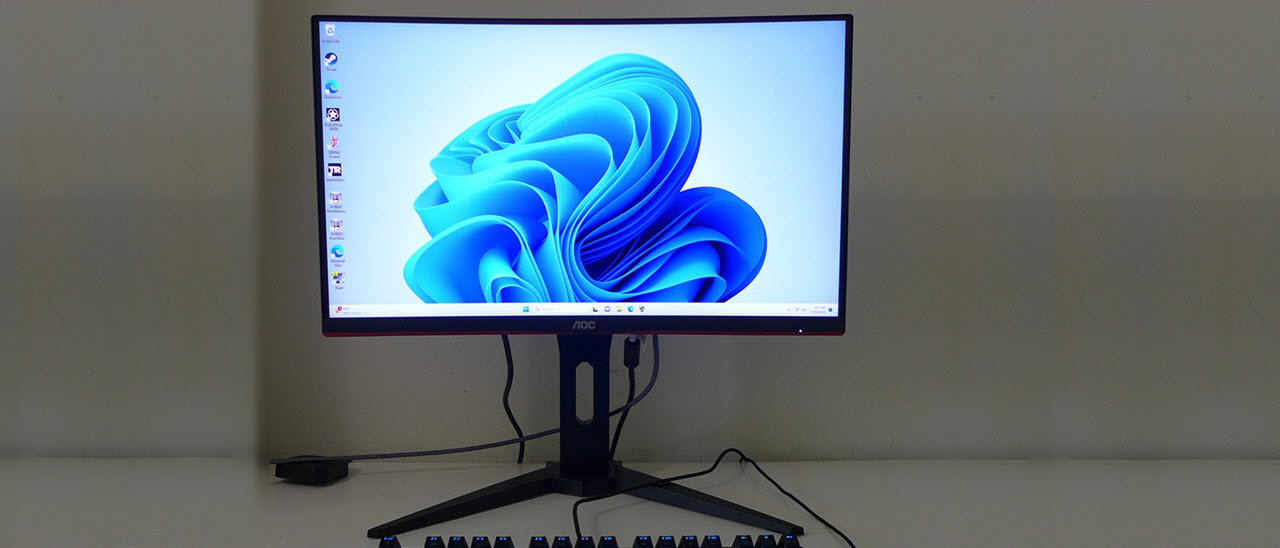Tom's Hardware Verdict
Aside from a weak overdrive, the AOC C24G1A has no flaws of consequence. Selling for just $150, there’s truly no cause for complaint. With superb contrast, saturated color and pro-level accuracy, it’s a compelling choice for gamers on a budget.
Pros
- +
Tremendous contrast and color saturation
- +
Pro-level accuracy out of the box
- +
Low input lag
- +
Excellent stand, styling and build quality
- +
Terrific value
Cons
- -
Weak overdrive
Why you can trust Tom's Hardware
When considering the least expensive products in any hardware category, bang for the buck is front and center. Desktop gaming monitors can be had for less than $100, including the Philips 221V8LN I recently reviewed, which sells for just $70. It offers a surprising level of performance, but then I have to ask, “What can I get for a little more money?” If you have $150 in your gaming monitor budget, AOC’s answer is, “Quite a lot!”
The C24G1A is a 24-inch curved FHD VA panel with 165 Hz, Adaptive-Sync and wide gamut color that sells for around $150 at this writing. That statement alone is most of what you need to know. But how does it perform? Let’s look at this contender to join the ranks among the best gaming monitors.
AOC C24G1A Specs
| Panel Type / Backlight | VA / W-LED, edge array |
| Screen Size / Aspect Ratio | 24 inches / 16:9 Curve radius: 1500mm |
| Max Resolution & Refresh Rate | 1920x1080 @ 165 Hz FreeSync: 48-165 Hz G-Sync Compatible |
| Native Color Depth & Gamut | 8-bit (6-bit+FRC) / DCI-P3 |
| Response Time (GTG) | 1ms |
| Brightness (mfr) | 250 nits |
| Contrast (mfr) | 3,000:1 |
| Speakers | None |
| Video Inputs | 1x DisplayPort 1.2 2x HDMI 2.0, 1x VGA |
| Audio | 3.5mm headphone output |
| USB 3.0 | None |
| Power Consumption | 20.9w, brightness @ 200 nits |
| Panel Dimensions WxHxD w/base | 23.6 x 15.3-20.3 x 6.9 inches (599 x 389-516 x 175mm) |
| Panel Thickness | 2.7 inches (68mm) |
| Bezel Width | Top/sides: 0.2 inch (6mm) Bottom: 0.8 inch (20mm) |
| Weight | 9.9 pounds (4.5kg) |
| Warranty | 3 years |
I applaud using VA panels for any monitor, but in the value category, they are essential. Why? Because their high contrast creates an image that is as good or better than the most expensive displays can boast. High-end is almost exclusively IPS-based, and while that technology has some perks, contrast is not one of them. VA consistently delivers around three times the dynamic range of any IPS screen, which anyone can see clearly.
The C24G1A comes out of the box with a 4,000:1 contrast ratio. That’s high even by VA standards. The picture is surprisingly colorful and accurate and this monitor does not require calibration. And if you can make a few tweaks, it’s even better. Pixel density is decent at 93ppi, tight enough that you won’t see the pixel structure at a three-foot viewing distance.
One thing I don’t always see with FHD monitors is a wide color gamut, but the C24G1A has one. It covers just over 88% of DCI-P3. This spec is becoming more common, though, and a few other screens are available in the value price category with that extra color volume.
The C24G1A doesn’t support HDR signals but includes three HDR emulation modes. No extra dynamic range is available, but through gamma manipulation, you get an approximation of HDR. It won’t generate a good chart from any display calibration software, but the look may appeal to some users. This feature’s effectiveness depends mainly on the content you’re viewing.
Gamers will surely delight in the C24G1A’s speed. It runs at a maximum of 165 Hz over DisplayPort and its two HDMI 2.0 inputs support 144 Hz. Adaptive-Sync runs on AMD and Nvidia platforms without issue. I confirmed G-Sync operation in my tests, but the C24G1A has not been certified by Nvidia. AOC also includes a backlight strobe feature that can be used instead of Adaptive-Sync.
Get Tom's Hardware's best news and in-depth reviews, straight to your inbox.
Outside of the core gaming performance features, the C24G1A includes an aiming point and a frame counter but not much else. It is attractively styled, and the curve is a definite value-add. Though one might wonder if curving a 24-inch screen is beneficial, this example has a subtle 1500R radius. My initial impressions are that it neither adds nor subtracts from the experience, but I’ll go into more detail about that later in the hands-on report.
The C24G1A presents a solid package for the money. It has stout build quality and an adjustable stand. There are no internal speakers or USB ports, but that’s not unusual for the price. With DisplayPort, HDMI and even a legacy VGA input, it can anchor various PCs and gaming systems.
Assembly and Accessories
The C24G1A comes in three parts from its colorful carton, which proclaims “Explore Worlds” in large type. The panel snaps into its mounting plate after bolting on the solid and stable base. If you’d rather use the 100mm VESA mount for your own hardware, fasteners are included. The power supply is internal, which I always like to see. That’s impressive in a monitor this small. You also get HDMI and DisplayPort cables.
Product 360
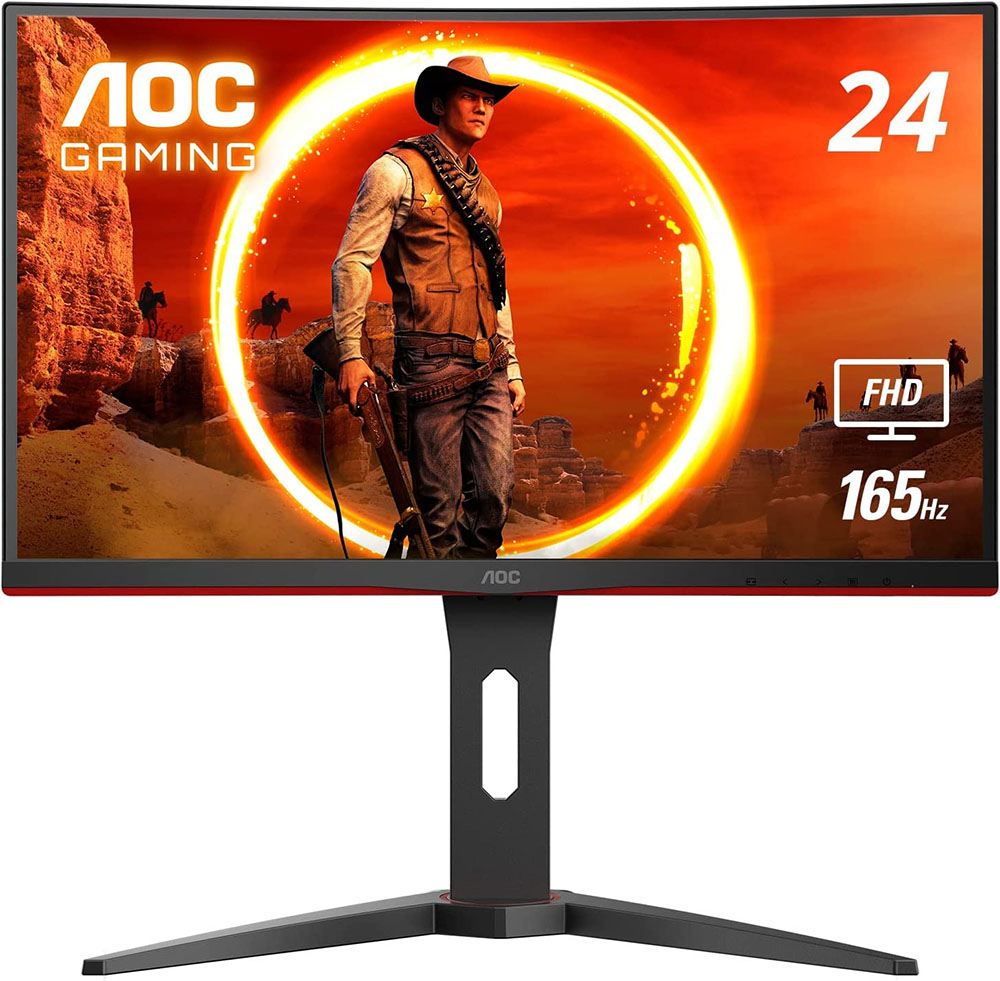
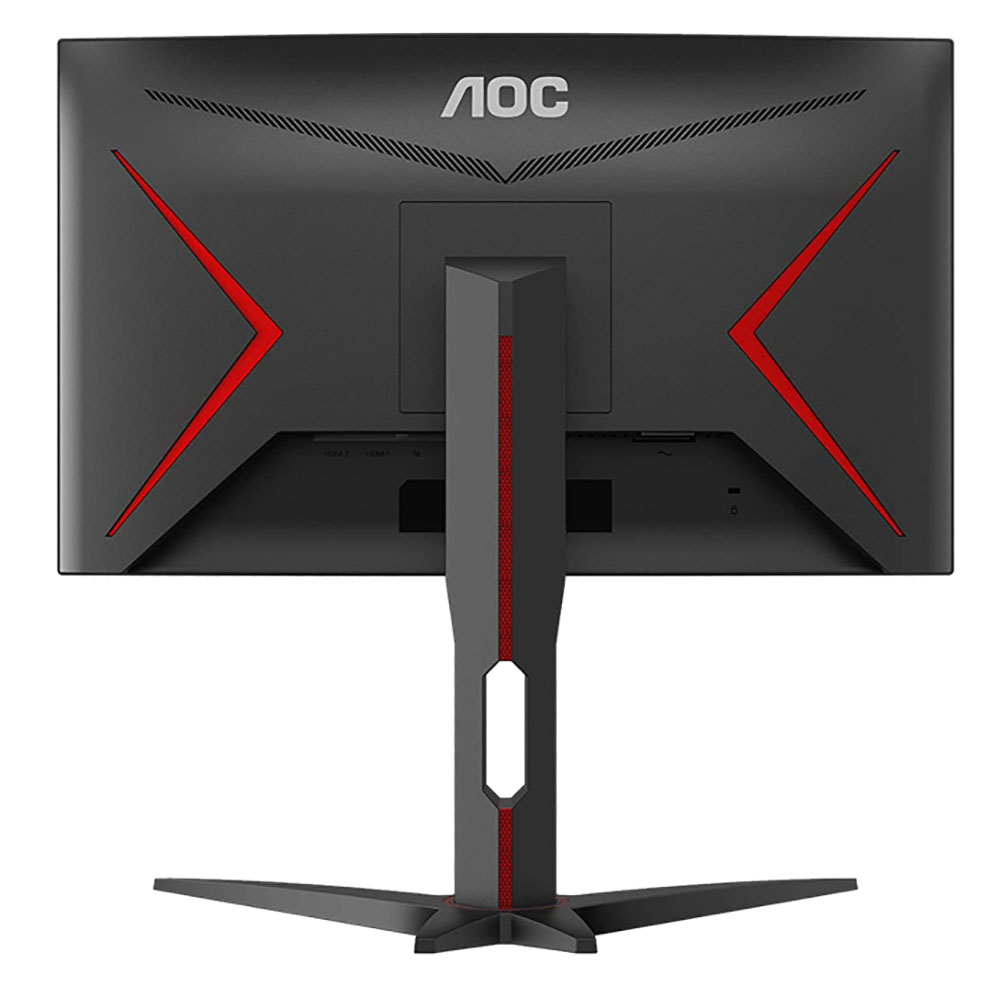
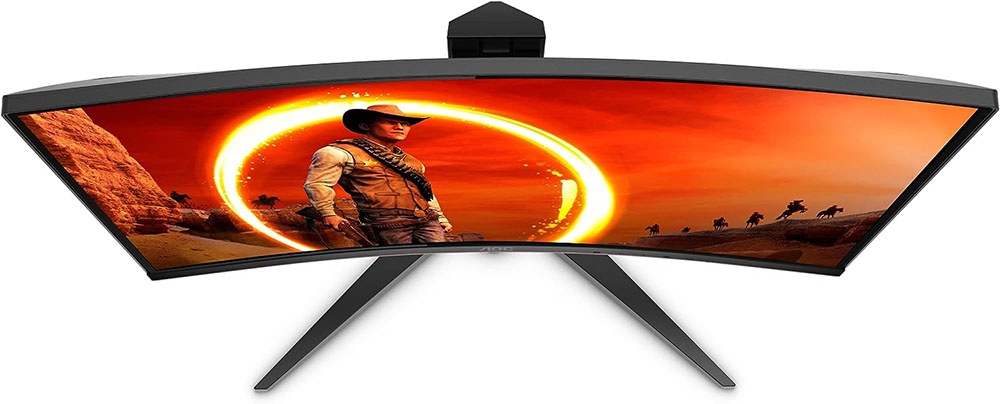
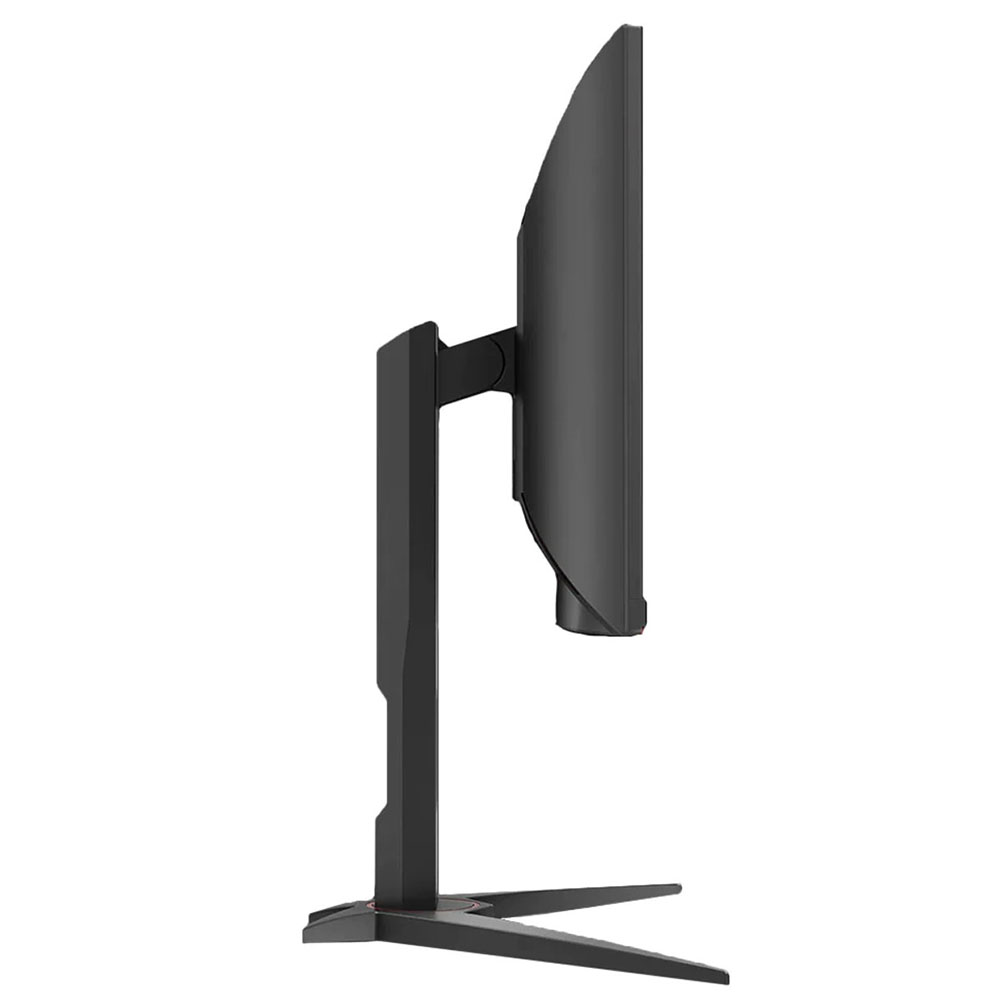
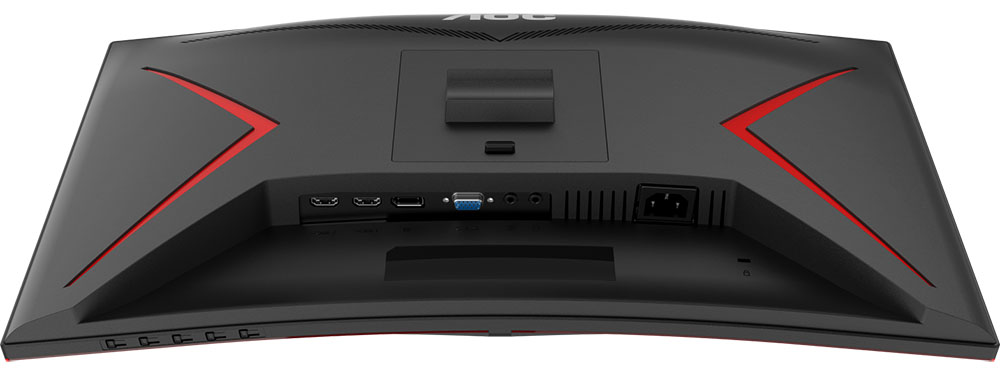
AOC touts the C24G1A’s bezel-less design and though it isn’t quite free of a frame around the image, the border is a scant 6mm around the top and sides with a 20mm strip across the bottom. In practice, the image makes it easy to ignore the flush bezel. You will notice the bits of red trim though. In lieu of a lighting feature, the red accents on the front, back and base pop nicely and clearly signal the display’s gaming intent. It’s just the right amount of bling.
The stand is of very high quality with a solid build and feel. It offers a 130mm height adjustment with 30 degrees swivel and 4/22 degrees tilt. There is no portrait mode. Considering that you can easily pay $150 for a good monitor arm, it’s impressive that AOC includes a fully functional and premium-grade stand, with a good screen, for the same money.
In the back, you’ll see more of that snazzy red trim in the form of two arrows (greater than, less than), and a thin line up the stand. A hole is provided there for cable management. And there is the potential for a lot of cables here. The C24G1A includes two HDMI 2.0 and one DisplayPort 1.2. You’ll need the latter for 165 Hz and G-Sync, while HDMI supports 144 Hz and FreeSync. You can also do 120 Hz with VRR from console gaming systems. AOC also includes a VGA input, which I haven’t seen in a long time. You can set the analog timing automatically in the OSD if you want to run the C24G1A with a vintage system. Audio support comes via a 3.5mm headphone/powered speaker output.
OSD Features
The C24G1A uses AOC’s tried and true ribbon OSD which appears across the bottom of the screen. The menu is reasonably intuitive and familiar. But I disliked the buttons used to control it. AOC uses control keys rather than joysticks on its less expensive models. And those buttons vary in the quality of their feel. The C24G1A’s buttons are small and don’t click with much authority. Though they got the job done, I found them frustrating to use.






The Luminance menu offers seven picture presets in the Eco Mode field. The Reading mode renders the picture in black & white. But Standard is the best choice because it conforms most closely to industry standards for color, white point and gamma. It does not need calibration. This menu also contains the three HDR emulation modes. They are a personal preference with no actual standard for their use. They’re labeled Game, Movie and Picture, along with three gamma options.
If you’re looking for the sRGB setting, it’s in the group of color temps, which also include warm, cool, normal and user. The RGB sliders are reasonably precise and can make a small improvement in accuracy. Picture Boost is AOC’s unique feature that renders a moveable and sizeable zone on the screen with its own brightness and contrast controls.
In Game Setting, you can toggle FreeSync/Adaptive-Sync, turn on the frame counter, choose between three overdrive settings, or turn on the backlight strobe. It’s called MBR and it only works once AS has been turned off. It visibly improves motion resolution but also suffers from the phasing artifact common to this feature. The overdrive is only slightly effective. It isn’t aggressive enough to make more than a small difference and I could still see black trail artifacts, which indicates undershoot.
In the Extra menu, you can toggle Auto Config for the VGA port’s phase and timing control. You can also change inputs and view signal information.
AOC C24G1A Calibration Settings
The C24G1A comes out of the box set to its Standard picture mode and does not require calibration. That’s really impressive for any monitor, especially one that only costs $150. You can see a tiny improvement by adjusting the RGB sliders in the color setup menu. Of the three gamma presets, number 1 hits the 2.2 standard almost perfectly. Gamma 2 is lighter and 3 is darker if you prefer that look. If you want to use the sRGB gamut, that option is one of the available color temps. It is extremely accurate as well. The settings I arrived at during testing are below. The C24G1A doesn’t support HDR but does include three HDR emulation modes. They alter gamma to approximate HDR but don’t expand dynamic range at all.
| Picture Mode | Standard (Game Mode Off) |
| Brightness 200 nits | 94 |
| Brightness 120 nits | 22 |
| Brightness 100 nits | 0 |
| Contrast | 49 |
| Gamma | 1 |
| Color Temp User | Red 52, Green 49, Blue 51 |
Gaming and Hands-on
Gaming with the C24G1A proved to be a solid experience. The low input lag I noted in testing was easily perceived, as I could aim accurately when moving quickly through the different maps in Doom Eternal. Control response was on par with other 165 Hz monitors I’ve tested.
I tried the various video processing options one by one. First, I switched on Adaptive-Sync and used the overdrive. There is some blur with that approach, but not enough to prevent me from successfully wading through many opponents. Detail in distant objects broke up a bit when I moved the mouse quickly. There are better monitors to use for sniping than the C24G1A. Its strength lies in more close-quarters combat. The overdrive’s undershoot created some black ringing around moving objects.
Next, I tried MBR, AOC’s backlight strobe option. This required that I first turn off Adaptive-Sync, so a few extra button-clicks to make that happen. MBR has 20 levels that make the image darker as you dial in more blur reduction. This is typical of all backlight strobes. Unfortunately, the brightness slider is grayed out, so you can’t turn up the backlight level to compensate. MBR shows a bit of the phasing artifact common to this technology. In practice, it manifests as extra outlines around areas of fine detail and moving objects. But since I was playing at 165fps consistently, the artifact was a bit less obvious than the overdrive’s weakness. So, I settled on MBR level 10 as the best choice for high-speed gaming.
The C24G1A doesn’t support HDR but includes three HDR emulation modes. These all proved inadequate for my purposes. All of them clip detail in the middle and brighter parts of the image. Any reduction in detail is unacceptable, especially when the resolution is FHD. I recommend avoiding the HDR emulations as they do the image no favors.
Sticking with the Standard Eco mode and Game Mode off was the best choice for all-around image quality. The C24G1A’s contrast is tremendous, with true black levels and very saturated color. You won’t find better color without spending a lot more money.
That image quality translates into a very usable monitor for daily tasks. The curve is barely noticeable when working on documents or surfing the web. Even in games, it wasn’t a factor. The C24G1A is a monitor where the curve neither enhances nor detracts from the image.
Takeaway: The C24G1A suits all work tasks and most game types. Weak overdrive makes it a bit less accurate when looking for detail in distant objects but if you are a fan of fast-paced shooters, it delivers excellent performance for the money.
MORE: Best Gaming Monitors
MORE: How We Test PC Monitors
MORE: How to Buy a PC Monitor
MORE: How to Choose the Best HDR Monitor
Current page: Features and Specifications
Next Page Response, Input Lag, Viewing Angles and Uniformity
Christian Eberle is a Contributing Editor for Tom's Hardware US. He's a veteran reviewer of A/V equipment, specializing in monitors. Christian began his obsession with tech when he built his first PC in 1991, a 286 running DOS 3.0 at a blazing 12MHz. In 2006, he undertook training from the Imaging Science Foundation in video calibration and testing and thus started a passion for precise imaging that persists to this day. He is also a professional musician with a degree from the New England Conservatory as a classical bassoonist which he used to good effect as a performer with the West Point Army Band from 1987 to 2013. He enjoys watching movies and listening to high-end audio in his custom-built home theater and can be seen riding trails near his home on a race-ready ICE VTX recumbent trike. Christian enjoys the endless summer in Florida where he lives with his wife and Chihuahua and plays with orchestras around the state.
-
Math Geek i have the original C24G1 and love it. well worth the $160 i paid for it. this updated one currently $119 on amazon is a steal.Reply
thinking hard about ordering 2 of them to replace my mis-matched dual screens i have now.. :) -
Sleepy_Hollowed This is an insane monitor, I am tempted to buy two as well, as 1080p is still the gaming sweet spot unless you need extra visibility of an ultra wide.Reply -
Anton Longshot A VERY long time ago I learned that once you get a bigger monitor, you can NEVER go back. But I suppose not everyone agrees with that as I often see TINY screens in shops and what's more, in reviews like this one.Reply
But then, I also don't play games on my laptop, ever...while laptop gaming is totally a thing elsewhere...iieeeuw. I guess I'll just stick to being amazed at what people do and refrain from judging them. :) -
Rexer I'm curious what the experience would be with a 165hz monitor for $120.00 from AOC. I bought into the 'cheap' monitor buys going with ViewSonic VX2418C ($130.00) and being humorously disappointed with the reality, I sorta laughed it off, "Oh well, you get what you pay for." Muddy details (even after adusting), game controller function knob broke and color for Display Port fritzed after 8 months (character flesh in games turned green. I RMA'd it two weeks ago. You can't adjust the hight, side to side and tilt but you buy it knowing that. Packaging was sort of suspect, small, minimum styrofoam, thin, unbleached corigated box, was least expensive packing I've seen for a monitor.Reply
Someone tell me they bought it and it's picturesque quality is pristine and refined. panel controls are easy to naviage and repsonds to shaders and is without washed color.
